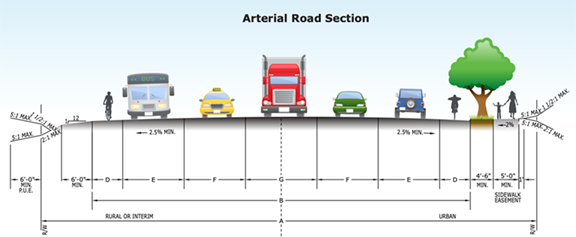Thompson Crossing decision raises questions about county planning

By Virginia Bruce
We asked Stephen Roberts, Director of Washington County’s Land Use and Transportation Department (LUT) to clarify the department’s reasoning in allowing the exceptions to county standards and plans for the Thompson Crossing development. While he didn’t explicitly answer every question, we’re including his responses below.
VB: Many of us are confused about how LUT arrived at the decision not to pursue the straightening of Thompson Road at the proposed Thompson Crossing site. But beyond that we have general questions about the force and effect of county community plans, road standards, and transportation plans. Do you view them as suggestions that can be ignored when developers want exceptions? What are the circumstances that justify abandoning plans in the face of developer pressure?

We’d like to better understand LUT’s commitment to community and transportation plans and justification for exceptions so we can know what to expect in future conflicts between these and the desires of developers.
SR: We acknowledge there are community members that disagree with and have appealed the County’s preliminary approval of the Thompson Crossing subdivision. Land Use & Transportation and County Counsel are working together to vigorously defend the appeal rights of these community members in Circuit Court in response to the developer’s Writ of Mandamus filing that appears intended to circumvent the normal land use appeal process.
We create plans, codes, and standards to guide future County and developer actions. Site-specific circumstances and other factors affect implementation, and there are many instances where strict application of a particular plan or code provision or a prescriptive standard is not practical or desirable due to specific, unique conditions. So, the plans, codes, and standards include processes to consider exceptions for site-specific circumstances through the development review and capital project development processes. These decisions involve balancing competing concerns and seeking the best outcomes based on the specific situation.
The developer has a right to develop this property, and County staff have carefully considered the unique circumstances of this development proposal. In this case, the Director of Land Use & Transportation approved the land use application. The County Engineer approves exceptions to the Road Standards.

VB: Right of Way (ROW) was obtained from the Thompson Highlands development for the realignment in 1992. Then, when LUT created the Bonny Slope West (BSW) Infrastructure Funding Plan, money for the realignment was included in the BSW System Development Charge. Why wasn’t there an effort to purchase the ROW from the property owner on the south side of the Thompson curves in order to bring this roadway up to County Road Design and Construction Standards? Is that still an option? What happened to the $4 million allocated for Thompson?
SR: The MSTIP Bonding Cost-sharing Program was approved by the Board of Commissioners in 2015. It earmarked future funding for improvements on Thompson Road, east and west of Saltzman Road. East of Saltzman, $4 million has been allocated for future improvements to Thompson Road between Saltzman and Marcotte roads: $2.67 million from MSTIP (Major Streets Transportation Improvement Program) bonding; $1.33 million from the Bonny Slope West System Development Charge fund.
The program schedule identified this project for design and construction in Years 7-10. The program is currently in its seventh year. $680,000 is programmed in the County’s Fiscal Year 2022-23 budget to initiate preliminary design for this project. When design work is complete, an updated construction cost estimate will be prepared. It is likely that the actual cost of the Thompson Road improvements will exceed the $4 million already allocated.
As noted, the developer has a right to develop this property. While future funding has been earmarked for the Thompson Road improvement project, the developer submitted an application to develop the property before funding is actually available to facilitate a potential purchase of right-of-way from the property.

VB: In a June 1, 2022, accident, a driver left this section of roadway, and their car came to rest against a wall when they lost control navigating this curve on Thompson Road. The driver narrowly missed a light pole that a 2020 accident here had destroyed—requiring replacement. In the face of drivers potentially turning to litigation as a result of these accidents, how does LUT explain the following actions?
- Exceptions to required sight distance at the Thompson/Hibbard intersection where this accident occurred.
- Exceptions to the Roadway Design and Construction Standards that require a design speed of 45 mph and 90 ft of ROW
- Exceptions to the Transportation System Plan: Thompson Road is TSP-designated as an arterial; the LUT exceptions for Thompson Crossing development are instead most consistent with the collector road designation. If the development is constructed as approved Thompson will never be an acceptable arterial.
Any exception to code must meet the criteria outlined (they don’t in this case) and be evaluated and compare favorably for safety compared with a road consistent with code standards (no comparisons with standards were made).
SR: Road Standard exceptions:
The Road Standards Design Exception process allows the County Engineer to approve deviations from a prescriptive standard, providing the road system function, performance, and safety are preserved. The County Engineer exercises professional engineering judgment to consider the specific context and evaluate trade-offs of any proposed exception. Crash history is one consideration.
Based on information provided to date, it appears the proposed exceptions for Thompson Road adjacent to the Thompson Crossing subdivision to the Road Standards can be approved. Design exceptions are considered and finalized once detailed engineering plans have been submitted for review so that all the site factors can be considered, and trade-offs evaluated.
County Road Standards:
220.020.1 Criteria for Exception: The County Engineer may grant an exception to the adopted specifications or standards when any one of the following conditions is met:
a. The specification or standard does not apply in the particular application;
b. Topography, right-of-way or other geographic conditions impose an economic hardship on the applicant and an equivalent alternative is available which can accomplish the same design objective;
c. A minor change to a specification or standard is required to address a specific design or construction problem which if not allowed will result in an undue economic hardship.

VB: The Bonny Slope West area in the Cedar Hills /Cedar Mill Community Plan (page 49) addresses this curve on Thompson by encouraging the county and the adjacent property owners to work together in solving the issue with the curve. Nowhere in the community plan is it suggested that the ultimate solution should ignore the problematic curves and allow design exceptions in the final design. How do you justify approving a substandard roadway?
SR: no answer
VB: Through my study of “takings” cases around the US, the jurisdictions who win them (and presumably those who avoid them in the first place) are those who have clear standards that are universally applied to all developers and enforced.
If Washington County’s community plans and road standards are only suggestions, is there a way to make them universal and enforceable so we can avoid the fear of court action that seems to have played a part in the Biggi decision?
SR: Takings concerns:
Cities and counties must carefully consider the legal principles of nexus and proportionality when reviewing development proposals. Nexus requires municipalities to demonstrate a direct link to the impacts of the proposed development and any requirements imposed on the development.
Proportionality requires municipalities to demonstrate that requirements imposed on the development are proportionate to the impact of the development. This limits municipalities’ ability to require significant transportation improvements for small developments like Thompson Crossing because they have limited impact (additional traffic) on the transportation system.
Municipalities imposing requirements that do not meet the nexus and/or proportionality standards can result in a legal ‘taking’ of development rights. In that case, municipalities must either pay the property owner/developer just compensation for the taking or remove the requirements. Takings case law is very clear; courts do not tolerate municipalities overreaching.
For nexus and proportionality, agencies have to consider the application of their standards in light of the particular development proposal and its impacts to make a determination of what is appropriate to require of/from the development. It’s the universal application of standards that often results in takings claims.
We appreciate the Director’s willingness to address our concerns. While we are gratified that the county is working to defend the community’s right to appeal land use decisions, we are concerned that public safety and community planning can be sacrificed in the face of a wealthy and litigious developer.
One consideration that CPO leaders have been looking at is that Current Planning, the department that handles development applications, is funded by development fees. The more development taking place, the bigger the LUT Current Planning budget. Does that affect LUT’s willingness to be so flexible? We wonder. That funding model is part of the County 2020 Strategic Plan (page 11), and it can be amended by the Board. Is it time to think about that? Are other fundamental aspects of county government ripe for change?





